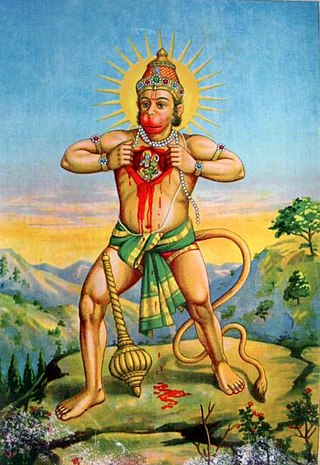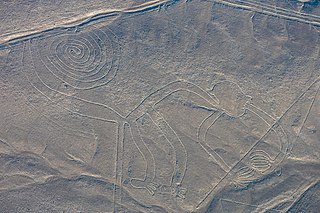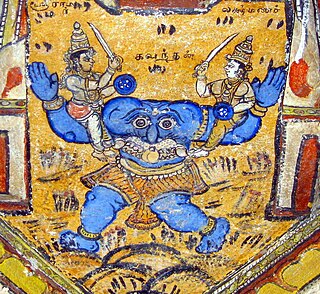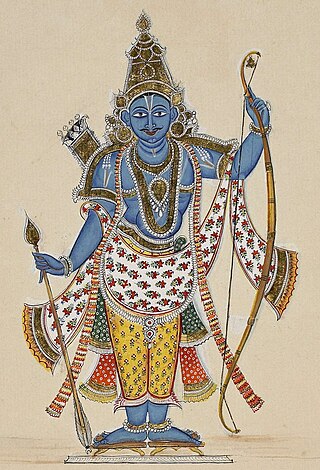
The Ramayana, also known as Valmiki Ramayana, as traditionally attributed to Valmiki, is a smriti text from ancient India, one of the two important epics of Hinduism known as the Itihasas, the other being the Mahabharata. The epic narrates the life of Rama, a prince of Ayodhya in the kingdom of Kosala. The epic follows his fourteen-year exile to the forest urged by his father King Dasharatha, on the request of Rama's stepmother Kaikeyi; his travels across forests in the Indian subcontinent with his wife Sita and brother Lakshmana; the kidnapping of Sita by Ravana, the king of Lanka, that resulted in war; and Rama's eventual return to Ayodhya along with Sita to be crowned king amidst jubilation and celebration.

Kartavirya Arjuna was a king of an ancient Haihayas kingdom with capital at Mahishmati which is on the banks of Narmada River in the current state of Madhya Pradesh. Kartavirya was son of Kritavirya, king of the Haihayas. According to the Puranas, Haihaya was the grandson of Sahasrajit, son of Yadu. This is his patronymic, by which he is best known; he is also referred to simply as Arjuna. He is described as having a thousand hands and a great devotee of god Dattatreya.

Hanuman, also known as Maruti, Bajrangabali, and Anjaneya, is a deity in Hinduism, revered as a divine vanara, and a devoted companion of the deity Rama. Central to the Ramayana, Hanuman is celebrated for his unwavering devotion to Rama and is considered a chiranjivi. He is traditionally believed to be the spiritual offspring of the wind deity Vayu, who is said to have played a significant role in his birth. In Shaiva tradition, he is regarded to be an incarnation of Shiva, while in most of the Vaishnava traditions he is the son and incarnation of Vayu. His tales are recounted not only in the Ramayana but also in the Mahabharata and various Puranas.

The Nazca lines are a group of geoglyphs made in the soil of the Nazca Desert in southern Peru. They were created between 500 BC and 500 AD by people making depressions or shallow incisions in the desert floor, removing pebbles and leaving different-colored dirt exposed. There are two major phases of the Nazca lines, Paracas phase, from 400 to 200 BC, and Nazca phase, from 200 BC to 500 AD. In the years leading up to 2020, between 80 and 100 new figures had been found with the use of drones, and archaeologists believe that there are more to be found.

Lakshmana, also known as Laxmana, Saumitra and Ramanuja, is a Hindu god and the younger brother of Rama in the Hindu epic Ramayana. He is considered as an incarnation of Shesha, the lord of serpents. Lakshmana was married to Urmila, and is known for his loyalty and dedication towards Rama.

The Vindhya Range is a complex, discontinuous chain of mountain ridges, hill ranges, highlands and plateau escarpments in west-central India.
Raghuvaṃśa is a Sanskrit epic poem (mahakavya) by the celebrated Sanskrit poet Kalidasa. Though an exact date of composition is unknown, the poet is presumed to have flourished in the 5th century CE. It narrates, in 19 sargas (cantos), the stories related to the Raghu dynasty, namely the family of Dilipa and his descendants up to Agnivarna, who include Raghu, Dasharatha and Rama.

Sita, also known as Siya, Janaki, Maithili, Vaidehi, Bhumija and Seetha is a Hindu goddess and the female protagonist of the Hindu epic Ramayana. Sita is the consort of Rama, the avatar of god Vishnu, and is regarded as an avatar of goddess Lakshmi. She is the chief goddess of the Rama-centric Hindu traditions and is known as the goddess of beauty and devotion. Sita is known for her dedication, self-sacrifice, courage, and purity.
Uttarakuru is the name of a dvipa ('continent') in ancient Hindu and Buddhist mythology as well as Jain cosmology. The Uttarakuru country or Uttara Kuru Kingdom and its people are sometimes described as belonging to the real world, whereas at other times they are mythical or otherworldly spiritual beings. The name Uttara Kuru means "North Kuru". The Kurus were a tribe during the Vedic civilization of India. The Uttara Kuru were therefore a population to the north of the Kurus, or north of the Himalayas.

The Paracas culture was an Andean society existing between approximately 800 BCE and 100 BCE, with an extensive knowledge of irrigation and water management and that made significant contributions in the textile arts. It was located in what today is the Ica Region of Peru. Most information about the lives of the Paracas people comes from excavations at the large seaside Paracas site on the Paracas Peninsula, first formally investigated in the 1920s by Peruvian archaeologist Julio Tello.

The Paracas Peninsula is a desert peninsula within the boundaries of the Paracas National Reserve, a marine reserve that extends south along the coast of Peru. The only marine reserve in the country, it is a designated UNESCO World Heritage Site. This is to mark and preserve the archeological sites of the Paracas culture, in addition to the marine habitat.
Peruvian art has its origin in the Andean civilizations. These civilizations rose in the territory of modern Peru before the arrival of the Spanish.

The Ashtadiggajas is a group of eight legendary elephants that appear in Hindu cosmology, serving as the guardians of the eight zones of the universe. There are also eight female elephants that stand beside the Ashtadiggajas, referred to as the Ashtadikkarinis.

The Battle of Ayohuma was a military action fought on 14 November 1813 during the Spanish American wars of independence. The forces of the Royal Army of Viceroyalty of Peru, commanded by Spaniard General Joaquín de la Pezuela defeated the Army of the North, led by General Manuel Belgrano in their second Upper Peru Campaign of the Argentine War of Independence.
In Pre-Incan mythology, Kón (Con) was the god of rain and wind that came from the North. He is thought to be a deity to the Paracas Civilization, who was later adopted into Nazca and Incan mythology through different names. He was a son of Inti and Mama Killa.

In Hinduism, Kabandha is a Rakshasa (demon) who is killed and freed from a curse by the god Rama – an Avatar of Vishnu – and his brother Lakshmana. Kabandha's legend appears in the Hindu epics Ramayana and Mahabharata, as well as in later Ramayana adaptations.
Kṛttivāsī Rāmāyaṇ,; also called Śrīrām Pãcālī, composed by the fourteenth-century Bengali poet Krittibas Ojha, from whom it takes its name, is a rendition of the Rāmāyaṇa into Bengali. Written in the traditional Rāmāyaṇa Pā̃cālī form of Middle Bengali literature, the Kṛttivāsī Rāmāyaṇ is not just a rewording of the original Indian epic, but also a vivid reflection of the society and culture of Bengal across the period of its circulation, from the Middle Ages into the modern period. It was characterised by Dinesh Chandra Sen in 1911 as 'by far the most popular book in Bengal' and 'the Bible of the people of the Gangetic Valley'.

Rama is a major deity in Hinduism. He is the seventh and one of the most popular avatars of Vishnu. In Rama-centric traditions of Hinduism, he is considered the Supreme Being.

Chryse and Argyre were a pair of legendary islands, located in the Indian Ocean and said to be made of gold and silver (argyros).
The Ocucaje Desert is a desert located in the Ica Province of the Ica Region in southern Peru between the Andes Mountains and the Pacific Ocean. It is part of the larger coastal desert of Peru, characterized by its dry, sandy landscape and significant archeological and paleontological importance.















